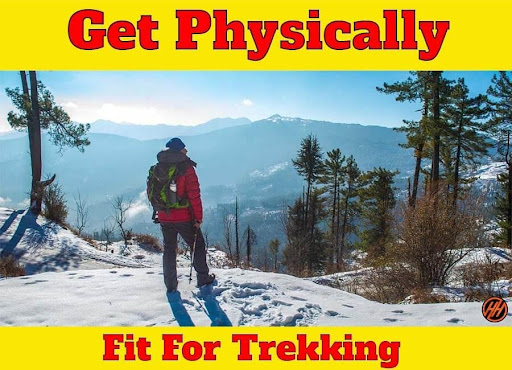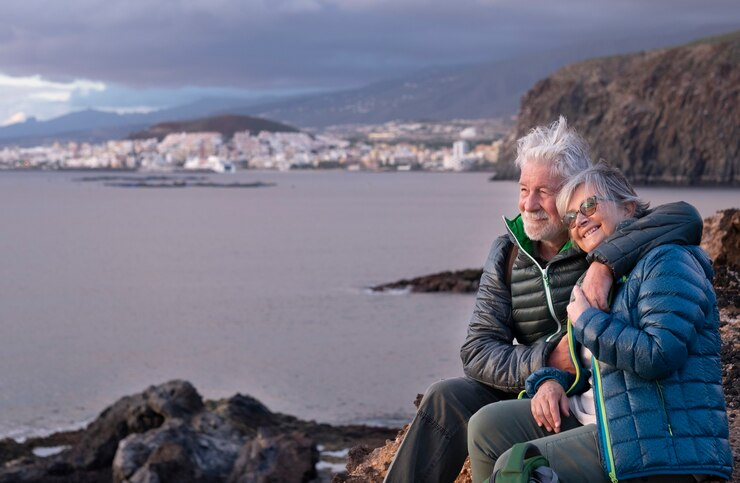Trekking evolved from the word “Trek” which typically means to go on a long arduous trip or journey, that too on foot while walking. So trekking is generally defined as walking into nature’s wilderness without using any modern transportation means.
Q.no.1: What is trekking meaning?
Ans: Trekking is commonly considered to be a multi-day walking continuously in any wilderness part of nature, which may be either a rugged and rural territory or any green area far away.
It is also defined as an interesting outdoor activity where there are no means of transportation and the trekker has to explore the beauty of nature by moving on his own feet.
Moreover, it could be either
- A commitment
- An aim
- A mission
- A far-off party
- A social gathering
- Friends get together
- An adventurous journey
Q.no.2: What to wear for trekking?
Ans: Proper dressing matters a lot while being on a journey as you don’t have enough choice to change your clothes again and again. Also, clothing items that disturb your frequent walk and in which you don’t feel comfortable enough are never suggested to be dressed upon during trekking.
However, you may choose to wear any of the following items below, but that too which are comfortable on your body and don’t stop you from walking:
- Underwear
- Shirts
- Pants/ Bottoms
- Jackets
- Socks
- Shoes (according to either personal preference, weather conditions, or trail terrain)
- Hats
Q.no.3: What are hiking and trekking?
Ans: Trekking and hiking are two wondrous activities that most nature exploring adventurers love to do and deeply enjoy. Although both these terms are online used interchangeably as the same thing, they are different to some extent.
- Hiking relates to an activity of waking on far-off walks, particularly across the country.
- While trekking means to go on a nature enjoying journey typically on foot.
Q.no.4: What is the difference between trekking and hiking?
Ans: Looking at the basic definitions of both these, one might distinguish properly between the two because to some extent they both essentially mean to go on long walks. However, they both differ in terms of
- Time duration of walking
- Route an individual follows
- The terrain
- Equipment carried for these activities
- Difficulty
Also, besides all these, hiking is defined as a “simple walk”, while trekking is designated as a “journey”
Q.no.5: What to carry for trekking?
Ans: For having a wondrous trekking experience, good quality equipment is essential to carry out with you. Those pieces of equipment like tents, heavy-duty swag bags, water bottles, batteries will allow you to stay safe and warm regardless of the weather conditions and fully enjoy your trek and hike.
The following equipment is worth carrying along with you while going out for it:
- Special boots
- A backpack
- A tent for accommodation
- A sleeping bag
- Compass, map, or a GPS device
Q.no.6: How to prepare for trekking?
Ans: No doubt, making a journey plan or thinking to trek in your holidays can be a little daunting and intimidating, especially when you are a beginner and going to try it for the very first time in your life.
So, the following is a step-by-step approach for preparing your mind and body for trekking and being fit and well to be able to move on your way to this adventure:
- Prepare yourself physically
- Do physical exercises you love and enjoy
- Mix up the terrain along with weather conditions
- Fuel your body with a healthy diet well
- Prepare yourself mentally
- Always remember to give yourself a pace
- Be persistent and consistent with your goals as they are the key to success
- Understand well the grade of your trip
- Preparing your gear feet
- Consider utilizing walking poles
- Do walking practice along with a backpack on your shoulders
- Determine the right footwear
Q.no.7: What to wear while trekking?
If you’re looking for a versatile and comfortable piece of gear to take on your next trek, consider 4inbandana.com custom neck gaiter. Their gaiters are made from lightweight, breathable fabric and can be customized to fit your specific needs. Plus, they’re easy to pack and take up minimal space in your backpack.
So, the following is a comprehensive list of clothing items that you can wear during this activity:
- Wicking Shirts
- Lightweight Hoody or Softshell Midlayer
- Windbreaker or Rain Jacket
- Trekking Shorts
- Pants/Leggings
- Rain Pants
- Merino Wool Socks
- Nylon or polyester Underwear
- Comfortable Boots or Shoes
- Neck Gaiter or Scarf
- Hat for Warmth or Cap for Sun Protection
- Special Backpack and many more
Q.no.8: How to join a trekking group?
Ans: In India, there are several websites that offer different upcoming events for trekking. Like for example,
- Townscript – www.townscript.com
- Mumbai Hikers – www.mumbaihikers.org
- Meetups near Mumbai – www.meetup.com
All these offer you to join the group of your interest. Besides these, you can also speak up to your friends who have recently trekked or either look for trek groups on social media platforms like Facebook and Instagram and join them.
Q.no.9: Which trekking is suitable for beginners?
Ans: If you are a beginner and going to trek for the very first time, then the Himalayan Range is an ideal option for you to have a wondrous journey. The beauty here is a very enchanting and fascinating range of mountains that provide an alluring charm and appeal to beginners.
The following are some top trekking expeditions in the Himalayan range for beginners:
- Hampta Pass
- Kedarkantha Trek
- Sandakphu Trek
- Valley of Flowers
- Trek to Beas Kund
- Chopta Tungnath Chandrashila Trek
- Har Ki Dun Trek
- Kuari Pass Trek
- Brahmatal Trek
- Brighu Lake Trek
Q.no.10: Which shoes are best for trekking?
Ans: A good pair of trekking shoes are a must to have for having an extraordinary experience and journey. Regardless of whatever brans you choose, they must feel like a great extension of your feet. Also, the comfort of walking should be their first priority as you have to move far-off while being on your feet. So, try to keep them at maximum ease. The following are the five best shoes to trek:
- Forclaz Trek 100
- Forclaz Trek 500
- Forclaz Trek 100 Leather
- Adidas Terrex AX2
- Salomon Quest 4D 3 GTX
Q.no.11: How to start a trekking business?
Ans: Staring a trekking business is a perfect business idea though, as many nature lovers usually tend to explore nature through this activity. Also, it promotes the beautiful spots of your region. However, there is nothing more required to start with this traveling business than to register it legally with the official ruling state there. The following are essential steps for establishing such a well-planned out business:
STEP 1: Plan your business
STEP 2: Form a legal entity
STEP 3: Register for taxes
STEP 4: Open a business bank account in any bank and get a credit card
STEP 5: Set up business accounting
STEP 6: Obtain necessary permits and licenses
STEP 7: Get business insurance
STEP 8: Define your brand and promote it
STEP 9: Create your business website
STEP 10: Set up your own business contact system
Q.no.12: How to start trekking?
Ans: Trekking, no doubt, is a great activity and journey to explore the wonders of nature. However, if you are a beginner at it and getting confused that where and how to start this activity, then given below is a quick guide for your ease. Just follow the steps mentioned below and you will have the best journey of your life.
Choose the right trail and start with small steps for reaching fitness level
- Familiarize yourself with the trail.
- Check the weather.
- Tell someone where you will be.
- Pack the 10 essentials.
- Navigation (map and compass)
- Sun protection (sunglasses and sunscreen)
- Insulation (extra clothing)
- Illumination (headlamp/flashlight)
- First-aid supplies
- Fire (waterproof matches/lighter/candle)
- Repair kit and tools
- Nutrition (extra food)
- Hydration (extra water)
- Emergency shelter (tent/plastic tube tent/garbage bag)
- Wear the right shoes and socks.
- Dress for success.
- Keep it backpack light.
- Pace yourself.
- Leave no trace.
- Enjoy your journey
Q.no.13: How to increase stamina for trekking?
Ans: Trekking is somehow an arduous activity in comparison to hiking, as it is much more than a simple walk. Also, it can be quite more demanding when you have to move uphill or scramble over uneven surfaces, that too while carrying a heavy backpack load on your shoulders. So, for this prolonged hard walking, you need to have enough strength and stamina. You can gain that through the following means:
- Prepare Your Feet for Extensive Walking
- Breathe More Efficiently
- Eat Quality Energy Foods
- Lose Some Extra Body Fat
- Lighten Your Pack Weight
- Full Body Weight Training
- Hike More!
- Cross Train
- Condition Uphill Muscles
- Work on Your Mental Strength
Q.no.14: How to get fit for trekking?
Ans: Physical fitness has always been a major concern for most trekkers especially for trekking at higher altitudes, steep climbs, walking in the snow, or rough terrains. No doubt, all of these can be very daunting for an unfit individual. However, they all can be easily tackled by someone who practices fitness training regularly before going out for a trek. The following are some tips and tricks to get fit for it though:
- Run or walk in the sand
- Build a range of motion
- Practice crunches to build core strength
- Do push-ups daily
- Perform squats and lunges
- Do cardio training
- Perform step-ups
Q.no.15: Why trekking is important?
Ans: For over several past years, trekking has been becoming popular day by day. It has now become a sort of addition for nature and adventure lovers though. However, still, there are a few beginners who require a bit of motivation to start it. However, once started they can’t be stopped as it is such a joyous activity in the current times with busy life schedules.
The following are some of the reasons why it is important to try at least once in life:
- For having some time for your own self
- To connect closely with nature
- In order to give your lungs a makeover
- For living practically and naturally
- Having eatables obtained from organic farming
Q.no.16: How to pack a trekking bag?
Ans: Before going out for trekking, one must have all the journey essentials handy in a backpack. Those items will let the trekker have a safe and sound journey. The following are the necessary things that one should keep in his backpack:
- Day backpack (25-40 L)
- Main travel luggage (70-80 L max.)
- Thermal underwear
- Wool/fleece thermal mid-layer and hat
- Foot-length pants
- Waterproof and breathable pants & jacket
- One pair of gloves either synthetic or made of wool
- 2-3 pairs of thick socks either synthetic or made of wool
- Waterproof boots, that too with good ankle support
- Sleeping bag and travel pillow
- Sunglasses and sunscreen
- River crossing shoes
- 1-2 liters water bottle
- Travel towel
- Swim gear (for some tours)
- Health supplies and prescription medicine
- Personal medical kit
- Personal toiletries
Q.no.17: What to eat during trekking?
Ans: As already discusses, trekking is somewhat an arduous task, so the body needs healthy eating fuel for it. Pack enough food in your bag and enjoy small ready-to-eat snacks (that don’t need to be cooked) every two hours while being on your trek. In this way, you will stay energized and enjoy whole your journey with friends without the need of stopping again and again.
The following is a list of the best foods that are easy to eat without the need of cooking during trekking. All of them supply your body with the essential nutrients and energy to move for prolonged time:
- Nutrition bars
- Energy chews or gels
- Fresh fruits and vegetables
- Trail mix
- Nuts and seeds
- Jerky
- Dried fruits and veggies
- Pork Rinds
- Hummus
- Cheese and many more



